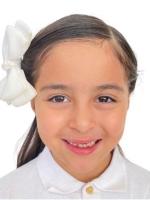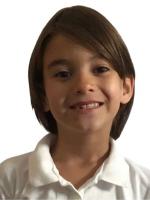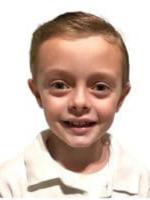

Building Innovative Readers: How to Bridge the Gap Between Reading and Understanding. |
Participate and share : Poster
Emilia La Rotta Reyes Patricio Díaz Sánchez Patricio González Rébora Santiago García Cerón Estrella Antonella García Gómez Laura De Vizcaya
Learn how pre-first students used design thinking and STEM to improve reading comprehension and to develop a love for literacy while enhancing creativity, innovation and decision-making processes within a problem-solving setting. Discover on the students' website the digital resources and artifacts they developed during meaningful reading sessions.
| Audience: | Principals/head teachers, Teachers, Teacher education/higher ed faculty |
| Skill level: | Beginner |
| Attendee devices: | Devices not needed |
| Topic: | Innovation in early childhood/elementary |
| Grade level: | PK-12 |
| Subject area: | ESL, STEM/STEAM |
| ISTE Standards: | For Students: Knowledge Constructor
|
| Additional detail: | Student presentation |
Reading is one of the most challenging and yet most fascinating skills educators can teach students to learn. However, in Mexico despite efforts like the National Reading Strategy and many marketing campaigns encouraging people to read more, little has been achieved to improve the 53rd place Mexico got in reading in 2019 according to the OECD. On the other hand, there are many issues that could be addressed to rebuild our nation and to improve the conditions for generations to come specially if we consider the cultural, social and economic backlash the global pandemic has been so far. Thus, there is an urgent need to educate young learners to become critical thinkers and readers that can recognize opportunities within problematic settings, that can envision possibilities and create innovative solutions to current problems.
In this sense, excellent reading skills and creativity are required to properly address economic, cultural and social problems in Mexico and the world. This can only be achieved if educators and school leaders take the matter seriously and think about different paths to encourage young learners to read and above all: comprehend texts.
Therefore, motivation is key to deepen students’ reading skills to promote a love for literacy. Using the correct strategies to address engagement in reading at an early age may lead this generation of students to reverse the equation and to better understand the world around them through proper reading and understanding.
In this sense, at Highlands International School we are convinced that good readers will become great leaders, teachers recognize the urgent need to teach our kids to become critical thinkers and readers, to be able to understand basic text structures setting the foundations for serious literary analysis in the years to come. On the same way they recognize that an improvement on students’ motivation towards reading is urgent so they adapted the design thinking process and STEM methodologies to help pre-first students discover in reading and understanding of leveled stories elements to apply their imagination, their creativity and knowledge within a problem-solving setting.
By using ESL and literacy skills students developed abilities for comprehension and problem solving. While reading fantasy stories they learnt there is a process to define problems and to come up with ideas to provide solutions, they acknowledge the steps of Design Thinking building the ground for making better questions and for providing solutions to different issues. In the long run, this empowered kids with critical skills for addressing real-world issues in the future.
A major benefit of distance learning is that students have become more independent in their learning processes and also experts on the use of technology to communicate their ideas and achievements. This is why technology and mastery of digital tools were important for this project since they allowed students to create material for a website whose purpose is to share this vision towards reading and literacy, as well as the work and innovative creations of our youngest students who applied ESL, literacy and technological skills to comprehend stories, define problems and propose solutions.
Join this inspiring session to witness the impact this project had at school and how all students from different reading levels within the same class had meaningful understanding during reading sessions even while learning from home and how they used innovation and critical thinking to come up with solutions to problems defined from leveled stories.
The main purpose and objectives for this presentation are:
- To share with the audience the development of a project that addresses the need for more effective engagement towards better comprehension and understanding.
- To prove how merging Design Thinking and STEM created the adequate motivation for improving comprehension, and for developing skills that build the foundations for creative and innovative problem solvers.
- To share students’ creativity when applying ESL and multiple literacy skills to communicate their ideas and achievements.
- To demonstrate there are different ways to use technology on a 1:1 instructional program to develop students ESL and literacy skills.
Larrey, M. (2017, November 9). Too many Mexican youth don’t read. We’re doing something about it. Worldreader. https://www.worldreader.org/blog/too-many-mexican-youth-dont-read/
Lenz, B. (2010, August 24). Preparing Students for STEAM Careers. Edutopia. https://www.edutopia.org/blog/stem-careers-students-preparation
OECD. (2019, December). Programme for international student assessment (PISA) results from PISA 2018. https://www.oecd.org/pisa/publications/PISA2018_CN_Mex.pdf
Starke, K. (2020, January 31), Developing a Love of Reading in Students. Edutopia. https://www.edutopia.org/article/developing-love-reading-students.
Wagner, T. Dintersmith, T., Graham, H. & Audio, S.S. (2015). Most Likely to Succeed: Preparing Our Kids for the New Innovation Era, Simon & Schuster Audio.
Wagner, T. (2015). Creating Innovators: The Making of Young People Who Will Change the World (Reprint ed.) Scribner






Laura De Vizcaya believes education is the main tool to empower future generations towards creating a better world. She has taught ESL disciplines, as well as world, art and Mexican history which are her passion. Laura's academic background on International Relations and Central European History built the foundations for her to acknowledge and recognize the need to educate critical thinkers and problem solvers to address current world issues. Her qualifications provide her with the credentials to merge both her passions: ESL and World History so that through research projects and curricular approaches she guides students and teachers to turn contemporary situations into meaningful learning experiences.